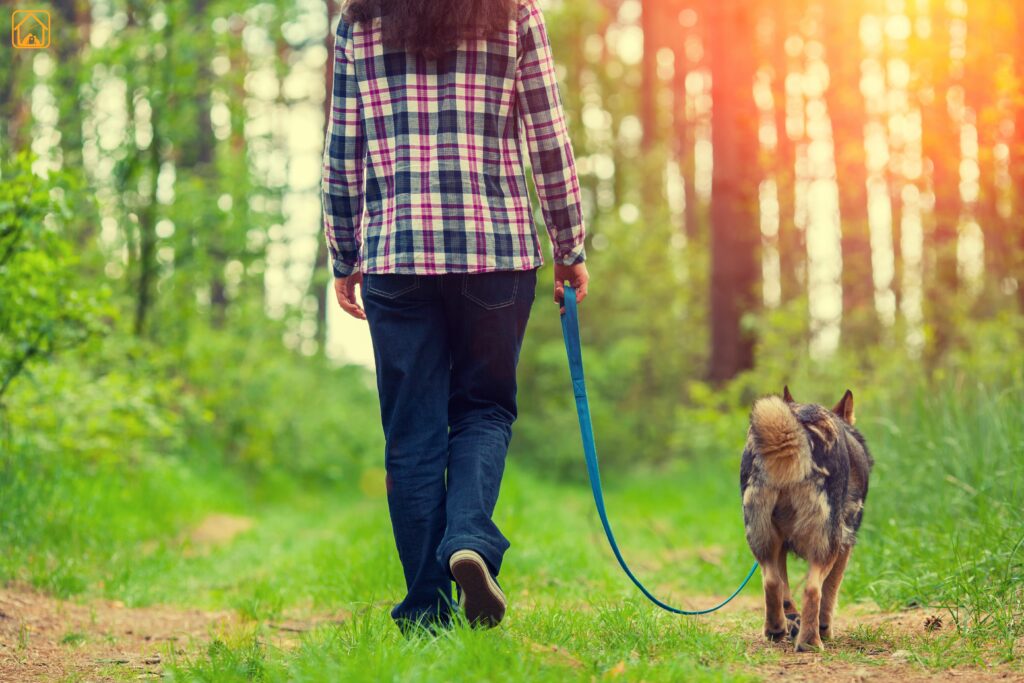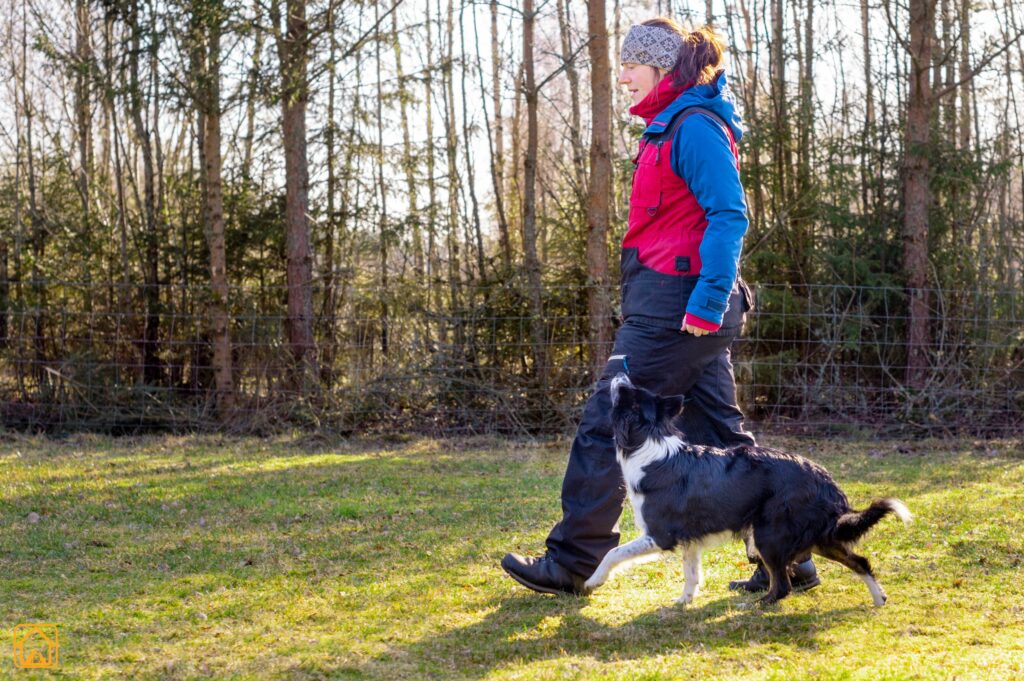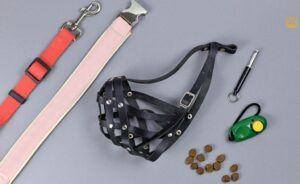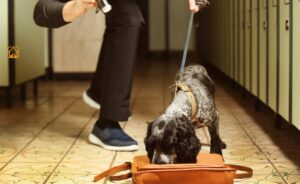Teaching your dog to heel means they walk calmly by your side, ignoring distractions like squirrels, smells, or passing cars. And the good news is with simple tools, consistency, and plenty of praise, dog heel training is totally doable for any pet parent. Whether you have a rowdy puppy or a strong adult dog, it’s never too late to turn chaotic walks into calm, happy ones. Let’s dive in and make walking your dog feel like a joy, not a workout.
Why Heel Training is Important for Dogs
Heel training isn’t just about fancy trick in obedience training, it’s about safety, freedom, and a closer bond with your dog. When your dog understands the heel command, walks become smoother and more predictable. You avoid tangled leashes, sudden lunges at squirrels, or risky dashes near traffic. Plus, heel training can reduce frustration and anxiety for both you and your pup.
I’ve watched anxious dogs completely change once they learn to walk calmly beside their humans. Dog heel training doesn’t just make walks easier, it helps build trust and confidence. Suddenly, those stressful walks through noisy streets or busy parks feel more relaxed. You’re not being dragged, and your dog isn’t panicking at every sound.
And honestly, there’s a little magic in that moment when your dog glances up at you, tail wagging, ready to follow your lead.
What Does ‘Heel’ Mean in Dog Training?
In dog training, ‘heel’ means your dog walks close to your left or right side, matching your pace and keeping their shoulder or neck roughly even with your leg. It’s more structured than loose leash walking, where your dog has a bit more freedom. In heel, your dog stays focused on you, and the leash remains relaxed without pulling.
Traditionally, dogs are taught to heel on the left, but you can choose whichever side fits your lifestyle. The most important part is Consistency. Once you pick a side and use a clear command like “heel,” stick with it. That way, your dog knows exactly what you want every time you say it.
Essential Equipment Needed for Heel Training
Having the right equipment makes dog heel training easier and safer. Here’s what you’ll need:
- Standard flat collar or harness: Pick a collar or harness that fits your dog properly, something comfortable and safe for their size and breed. A harness can be a great choice if your dog tends to pull.
- Leash: A 4-6 foot leash gives you good control without restricting movement. This length gives you enough control while still allowing your dog to move naturally. Some people prefer a leash made specifically for heel training, but a regular one works just fine too.
- Treats: Go for small, soft treats your dog gets excited about. You’ll be using them often to reward good behavior, so keep a handful handy. A treat pouch can help keep your hands free and training smooth.
- Clicker (optional): A clicker lets you mark the exact moment your dog gets it right, which helps them learn faster. But if you don’t have one, don’t worry, your voice and timing work too.
Some trainers use a hand signal heel command or a heel training stick, but for most pet parents, treats and a leash are enough to start.
When and How to Start Heel Training (Puppies & Adults)
Wondering what age to teach a dog to heel? Puppies can begin learning heel basics as early as 8-10 weeks, using gentle, positive methods. Adult dogs can learn too, it’s never “too late” for heel training!
Getting Started: Setting the Stage
- Start in a quiet, distraction-free spot (think living room or hallway).
- Keep sessions short, 5-10 minutes for puppies, 10-15 for adults.
- Focus on fun. If you or your dog get frustrated, take a break.
I’ve worked with bouncy puppies and stubborn seniors; honestly, the biggest difference is patience. Both can learn, but some dogs may need slower steps or extra encouragement. And if you’re teaching a small dog to heel, consider their height when rewarding, treats should be delivered at their level.
Step-by-Step Heel Training Indoors: Foundation Skills

Starting heel training indoors is a smart way to set your dog up for success. With fewer distractions and a familiar space, your dog can focus better and build confidence before taking these skills outside. Here’s how to begin:
1. Mark the Heel Position
Put your dog on a leash and stand still in a quiet room. Gently lure them to your chosen side, left or right and make sure their shoulder lines up with your leg. As soon as they’re in the correct spot, say “yes!” or use a clicker, and give them a treat. This helps them understand where “heel” actually is.
2. Add a Little Movement
Now, take one step forward. If your dog follows and stays beside you, mark the behavior and give a reward. Keep repeating this, slowly adding more steps. If they get distracted or move ahead, pause, reset gently, and try again. Keep it light and encouraging.
3. Introduce the Heel Cue
Once your dog is following nicely, start adding the cue word “heel” just before you step forward. Over time, they’ll begin to associate the word with walking calmly by your side.
4. Practice Repetition and Keep It Fun
Walk around different areas of your home, changing direction often. This teaches your dog to stay focused and adjust with you. As they improve, begin to reward randomly instead of every step. This builds lasting behavior and keeps them engaged.
I’ll never forget one rescue dog I trained, she looked so proud the first time she stayed in heel for a few steps. That little tail wag said it all: “I did it!”. Small wins matter!
Transitioning Heel Training Outdoors & Adding Distractions
Once your dog is nailing heel training indoors, it’s time to go outside. Here’s where real-world distractions come in, other pets, smells, people. Start in your yard or quiet street and gradually build up.
- Keep initial sessions short and positive. Use higher value treats if needed.
- Walk short distances, rewarding your dog for staying in heel position.
- Slowly increase distractions, move to busier sidewalks or parks as your dog succeeds.
Don’t worry if your dog forgets everything at first (it happens!). Just go back a step and rebuild confidence. That “aha!” moment when your dog chooses you over a squirrel? That’s gold.
Advanced Heel Training: Off-Leash, Duration, and Public Places
Once your dog is reliable on leash, you can try off-leash heel training in a safe, fenced area. Start with short, focused sessions and use a release word (like “free” or “okay”) so your dog knows when heel time is over.
Building Duration and Distance
To build duration, slowly increase how many steps your dog must stay at your side before earning a reward. Don’t rush, some dogs need time to develop the focus and self-control heel work requires. As your dog improves, try training in more distracting places like your neighborhood park, a quiet sidewalk, or even a pet-friendly store. Always keep the leash on in public for safety.
Advanced heel training techniques include adding turns, changes of speed, or even heeling through crowds. Some dogs love the challenge! The key is to keep sessions fun and give plenty of breaks. If your dog struggles, just shorten the session, no big deal.
The real goal of advanced heel training is teamwork. With time and practice, your dog learns to move with you like a partner, not just a pet on a leash.
Common Mistakes and Troubleshooting Heel Training
Even seasoned owners slip up with heel training. Some common heel training mistakes:
- Pulling the leash instead of letting your dog choose to heel.
- Rewarding in the wrong position, keep treats close to your leg.
- Expecting too much, too fast. Dogs need practice and patience.
- Skipping practice around distractions or outdoors.
If you hit a roadblock, step back to simpler exercises or try new rewards. When my own dog hit a rough patch, swapping to cheese (her favorite) made all the difference. If frustration sets in, take a break, training should be fun for both of you!
Positive Reinforcement Techniques: Treats, Hand Signals, and Clicker Training
Positive reinforcement heel training is the gold standard. Here’s how:
- Treats: Use them generously at first, then fade as your dog learns. Try teaching dog to heel with treats, and later mix in praise or play.
- Hand signals: Pair a clear gesture (like patting your side) with your verbal heel command for extra clarity. Hand signal heel command works especially well in noisy places.
- Clicker: Clicker training for heel gives instant feedback, making learning faster for many dogs.
Ever tried positive reinforcement and seen your dog’s tail go wild with happiness? It’s a win-win, your dog learns faster, and you both enjoy training time more.
FAQs: Dog Heel Training
How long does it take to teach a dog to heel?
Most dogs can learn the basics in a week or two with daily practice. Mastery takes longer, especially around distractions. Some dogs might take a month or more, patience is key.
What age should I start heel training my puppy?
You can start puppy heel training as early as 8-10 weeks. Use gentle, positive methods and keep sessions short and playful.
Can I teach my dog to heel without treats?
Absolutely. Once your dog knows the basics, you can switch to praise, petting, or a favorite toy. But treats usually speed up learning for most dogs.
What’s the difference between loose leash walking and heel?
Loose leash walking means your dog can explore but shouldn’t pull. Heel is more precise, your dog stays right by your side, focused on you, with a slack leash.
Do I need a special leash or equipment for heel training?
No special gear is required, but a standard leash and harness work best for most dogs. Avoid retractable leashes, they make consistent training harder.
How do I teach a small dog to heel?
The process is the same, but be extra mindful of rewarding at their level. Use tiny treats and bend down if needed so your small dog stays motivated and clear on what you expect.
My dog loses focus around other dogs. What can I do?
Practice heel training with mild distractions first, then work up to busier places. Use high-value treats and keep sessions brief. If your dog gets overwhelmed, move to a quieter area and try again.
Conclusion
With dog heel training, every walk becomes a chance to bond and build trust. Celebrate small wins, keep it positive, and remember, even the wiggliest dog can learn to walk beside you with a little time and a lot of love.



